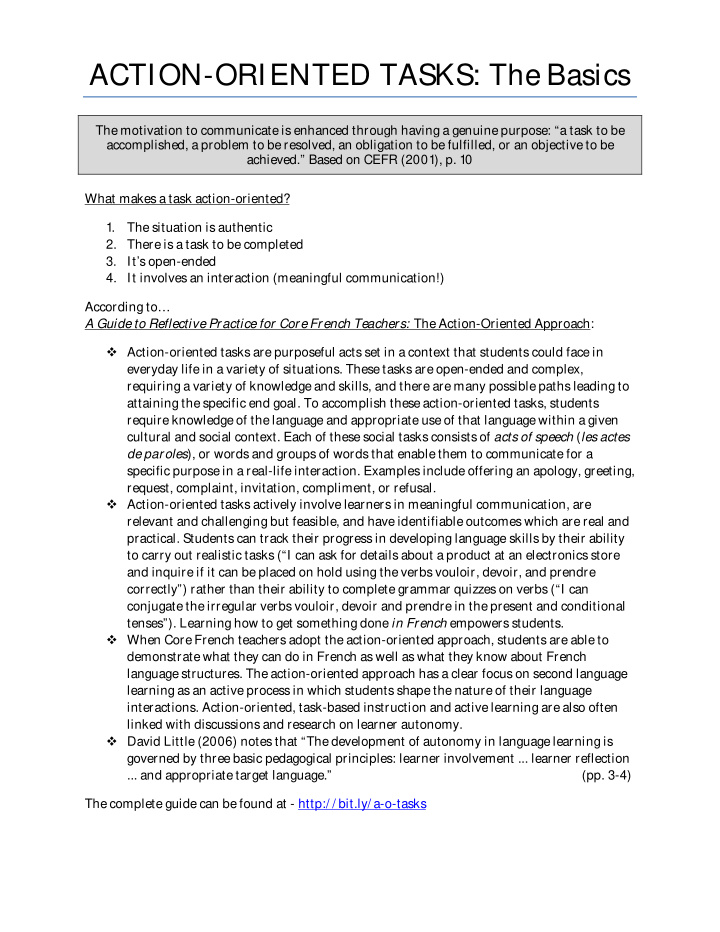



ACTION-ORIENTED TASKS: The Basics The motivation to communicate is enhanced through having a genuine purpose: “a task to be accomplished, a problem to be resolved, an obligation to be fulfilled, or an objective to be achieved.” Based on CEFR (2001), p. 10 What makes a task action-oriented? 1. The situation is authentic 2. There is a task to be completed 3. It’s open-ended 4. It involves an interaction (meaningful communication!) According to… A Guide to Reflective Practice for Core French Teachers: The Action-Oriented Approach: Action-oriented tasks are purposeful acts set in a context that students could face in everyday life in a variety of situations. These tasks are open-ended and complex, requiring a variety of knowledge and skills, and there are many possible paths leading to attaining the specific end goal. To accomplish these action-oriented tasks, students require knowledge of the language and appropriate use of that language within a given cultural and social context. Each of these social tasks consists of acts of speech ( les actes de paroles ), or words and groups of words that enable them to communicate for a specific purpose in a real-life interaction. Examples include offering an apology, greeting, request, complaint, invitation, compliment, or refusal. Action-oriented tasks actively involve learners in meaningful communication, are relevant and challenging but feasible, and have identifiable outcomes which are real and practical. Students can track their progress in developing language skills by their ability to carry out realistic tasks (“I can ask for details about a product at an electronics store and inquire if it can be placed on hold using the verbs vouloir, devoir, and prendre correctly”) rather than their ability to complete grammar quizzes on verbs (“I can conjugate the irregular verbs vouloir, devoir and prendre in the present and conditional tenses”). Learning how to get something done in French empowers students. When Core French teachers adopt the action-oriented approach, students are able to demonstrate what they can do in French as well as what they know about French language structures. The action-oriented approach has a clear focus on second language learning as an active process in which students shape the nature of their language interactions. Action-oriented, task-based instruction and active learning are also often linked with discussions and research on learner autonomy. David Little (2006) notes that “The development of autonomy in language learning is governed by three basic pedagogical principles: learner involvement ... learner reflection ... and appropriate target language.” (pp. 3-4) The complete guide can be found at - http:/ / bit.ly/ a-o-tasks
According to A Guide to Reflective Practice for Core French Teachers : Oral Proficiency: The Common European Framework of Reference for Languages (CEFR) highlights the action-oriented approach, student self-assessment, the use of “can-do” statements, and the development of language skills that are relevant to authentic situations. The CEFR stresses the importance of developing oral proficiency and differentiates between oral production and oral interaction. The framework endorses an attitude that values language learners’ ability to communicate while gradually increasing their accuracy with practice over time. In the early stages of language learning, the goal is to communicate the intended message in the target language, recognizing that errors in form will be evident. Language learners are encouraged to develop and use skills related to the functions of language rather than to learn about the language. As described by Puren, the action-oriented approach has evolved from and builds upon the characteristics of the communicative approach by considering the learners as social actors who interact for a genuine purpose such as presenting a convincing argument, making a purchase, confirming travel arrangements, or discussing current events. Before students start any work, the teacher first ensures that they have a foundation of French language skills and communication strategies needed for beginning the task. While students work collaboratively, the teacher provides feedback to build their language skills. (p. 3) The complete guide can be found at - http:/ / bit.ly/ or-prof Resources (Presenter is not affiliated with any of these products) Free resources: A Guide to Reflective Practice for Core French Teachers: The Action-Oriented Approach (Mentioned above) http:/ / bit.ly/ a-o-tasks A Guide to Reflective Practice for Core French Teachers : Oral Proficiency (Mentioned above) http:/ / bit.ly/ or-prof From Communicative to Action-Oriented: A Research Pathway (Chapter 5 includes examples) http:/ / bit.ly/ fromctoao Resources available for purchase: AIM : CEFR Action-Oriented Tasks Resources Book ($89) http:/ / bit.ly/ aimaotasks CASLT Assessment in Action: A CEFR-based Toolkit for FSL Teachers ($18 Members, $30 Non-Members – Available in Level A or B) http:/ / bit.ly/ casltaat
Curriculum Overall Expectation: Learning Goal: Situation: Primary Action-Oriented Task Junior Action-Oriented Task Additional tasks to support: Structures and/ or functional language:
Recommend
More recommend